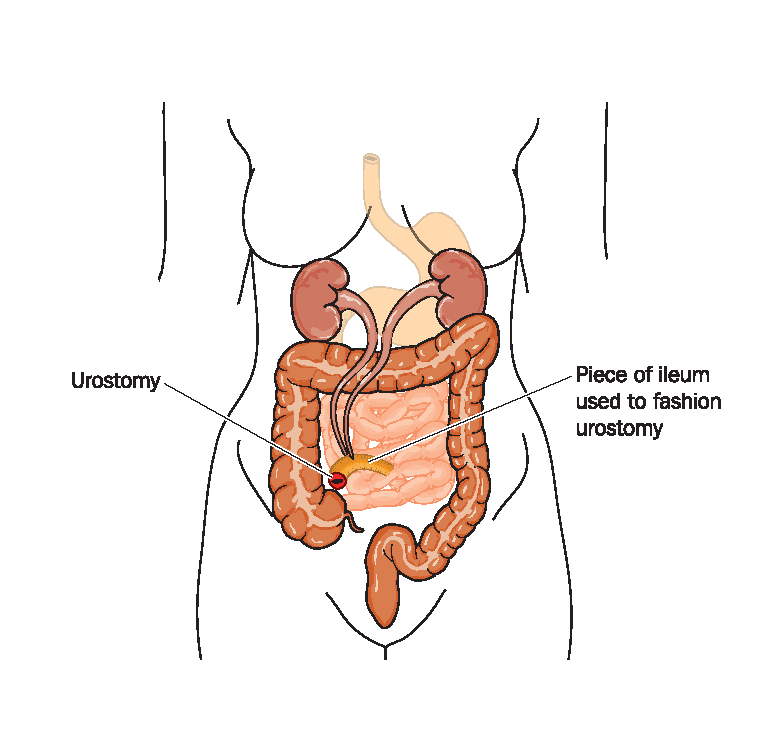Urostomy
Urostomy (Urinary Diversion): A surgically created opening in the abdominal wall through which urine passes. A urostomy may be performed when the bladder is either not functioning or must be removed. There are several different types of surgeries, but the most common are ileal conduit and colonic conduit.
On occasion, it may be a direct opening from the ureters or bladder, but by far the most common urostomy is the ileal conduit. The ileal conduit uses a short segment of the small bowel, isolated from the rest of the bowel but with its blood supply intact, to provide a means of conveying urine from the ureters to the outside collecting appliance. To one end of this short piece of bowel the ureters are attached, and the other end is brought through the abdominal wall to form a stoma. The stoma is fashioned as a spout to allow a collecting appliance to be fitted and to prevent urine encountering the seal of the appliance to the abdominal wall. Urine is produced continuously down the ureters into the bowel segment and hence to the outside. Intermittent contractions of the bowel segment, in an ordered fashion, called peristalsis, aid the passage of urine along the conduit and lead to the urine being discharged from the stoma in small spurts, at regular intervals. Whether the bladder is removed or remains is of no significance to the function of the ileal conduit. The person’s own bladder may need to be removed because of the disease process that destroyed it, or it may be left behind as a functionless organ that is now no longer in use. Because of the success of urostomy appliances in providing leak-free systems, an ileal conduit may the best way of managing an otherwise unmanageable incontinence. Occasionally an internal pouch is formed on the inside of the abdomen using a segment of bowel and is emptied by intermittent catherization.
Reasons for surgery: Bladder cancer, spinal cord injuries, malfunction such as chronic infection of the bladder and birth defects such as spina bifida.

Care of a Urostomy
A Pouching system is usually worn. Pouches are odour free and different manufacturers have a variety to fit one’s lifestyle and needs. Ostomy supplies will come through your Stoma Nurse.
Living with a Urostomy
Work: With the possible exception of jobs requiring very heavy lifting, a urostomy should not interfere with work. People with urostomies are successful businesspeople, teachers, carpenters, welders, etc.
Sex and social life: Sexual function is influenced by the reasons for which the urostomy is performed. The urostomy itself should not interfere with normal sexual activity or pregnancy. It should not prevent one from dating and continuing relationships and friendships.
Clothing: Usually one is able to wear the same clothing as before surgery including swimwear.
Sports and activities: With a securely attached pouch one can swim and participate in practically all types of sports. Caution is advised in heavy body contact sports and a guard or belt can be worn for protection. Travel is not restricted in any way. Bathing and showering may be done with or without the pouch in place.
Diet: Usually there are no dietary restrictions and foods can be enjoyed as before. It is suggested that 8-10 glasses of fluid per day be consumed to help decrease the chance of kidney infection.
Sleep: Night drainage systems are available to collect and store urine so can sleep without having to empty your bag multiple times during the night.
Possible Complications: A defect with an ileal conduit as opposed to the normal bladder is that it can be quite seriously infected without causing any symptoms noticeable to the urostomate. If this is unrecognised then the infection can develop into a more severe one with complications. Therefore, regular taking of specimens of urine or examination using a catheter inserted into the conduit to look for silent infections is sometimes advised. Stone formation is usually a result of infection, inadequate fluid intake and dietary factors. Kidney damage can result from uncontrolled infection or be a reflection of the back-pressure effects. Reabsorption of some urine constituents in the ileal conduit, especially chloride and acid, can occasionally cause nausea, vomiting, lethargy, over breathing and even coma. This can be prevented by treatment from your doctor and detected early by blood tests. Urine appears intermittently at the stoma, being discharged in small spurts, but ejection of urine in narrow, long streams indicates obstruction at the stoma. This may require surgical attention. Crystals may form in the urine; some being deposited on the skin immediately around the stoma. At each appliance change the crystals should be thoroughly rinsed away to prevent skin excoriation.

